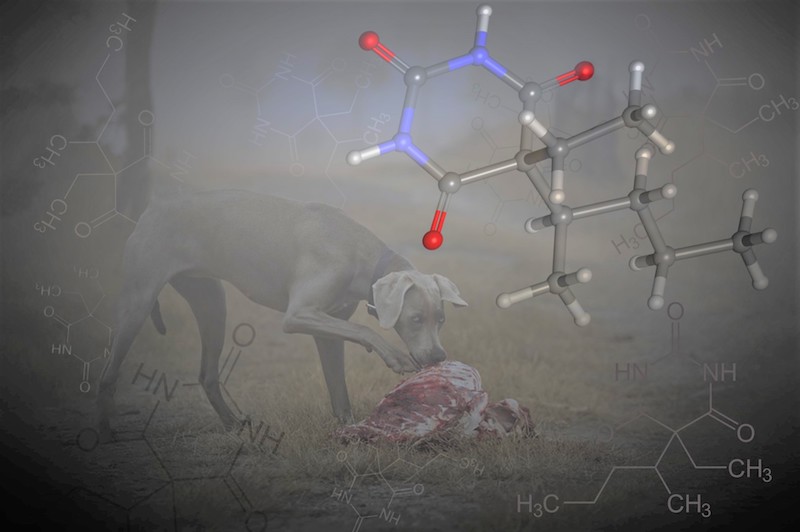The detection of pentobarbital in euthanized domestic dogs
DOI:
https://doi.org/10.32473/jvfs.v1i1.128309Keywords:
veterinary forensic sciences×, pentobarbital, GC-NPD, euthanasia, toxicology, pathologyAbstract
This preliminary study examined the postmortem distribution of pentobarbital in the remains of three domestic dogs (Canis lupus familiaris) after intravenous administration of pentobarbital sodium to determine optimal sampling practices for veterinary forensic casework. It was thought that pentobarbital would be absent in many traditional toxicological samples, such as bile and urine, because of the brief period between administration and death. However, all samples tested via gas chromatography, coupled with a nitrogen–phosphorus detector, contained quantifiable levels of pentobarbital. These initial results suggest that when the Florida Animal Control Association’s recommended method of euthanasia is used in healthy individuals, pentobarbital extensively distributes throughout the body.
Published
Issue
Section
License
JVFS supports the need for authors to share, disseminate, and maximize the impact of their research. We take our responsibility as stewards of the online record seriously and work to ensure our policies and procedures help protect the integrity of scholarly works.
License to the journal. The author hereby licenses to the journal the irrevocable, nonexclusive, and royalty-free rights as follows:
- The journal may publish the article in any format, including electronic and print media. Specifically, this license includes the right to reproduce, publicly distribute and display, and transmit the article or portions thereof in any manner, through any medium now in existence or developed in the future, including but not limited to print, electronic, and digital media, computerized retrieval systems, and other formats
- The journal may prepare translations and abstracts and other similar adaptations of the article in furtherance of its publication of the article.
- The journal may use the author's name, likeness, and institutional affiliation in connection with any use of the article and in promoting the article or the journal.
- The journal may exercise these rights directly or by means of third parties. The journal may authorize third-party publishers, aggregators, and printers to publish the article or to include the article in databases or other services. [Examples of such third parties include Westlaw, Lexis, and EBSCO.]
- The journal may, without further permission from the author, transfer, assign, or sublicense the rights that the journal has pursuant to the Agreement.
- To foster wider access to the article, especially for the benefit of the nonprofit community, the author hereby grants the journal the authority to publish the article with a Creative Commons "Attribution, Non-Commercial, No Derivatives" license. [The author should consult the Creative Commons website for further information.]
- This license of rights to the journal shall take effect immediately. In the event that the journal does not publish the article, this license to the journal shall terminate upon written notification by the journal to the author, or upon the termination of all publication by the journal. To the extent that moral rights may apply to the article, this Agreement does not affect the moral rights of the author in or to the article.
Rights of the author. Without suggesting any limit on other rights that the author may have with respect to the article, the author retains the following rights. To the extent that the journal holds similar rights with respect to the article consistent with this Agreement, the author shall hold these rights on a nonexclusive basis. To the extent that the article includes edits and other contributions by the staff of the journal, the rights of the author in this paragraph include the right to use such edits and contributions.
- The author may publish the article in another scholarly journal, in a book, or by other means. The author may exercise this right of publication only after the date of the first publication of the article in the journal in any format.
- The author shall, without limitation, have the right to use the article in any form or format in connection with the author's teaching, conference presentations, lectures, other scholarly works, and for all of the author's academic and professional activities.
- The author shall at any time have the fright to make, or to authorize others to make, a preprint or a final published version of the article available in digital form over the Internet, including, but not limited to, a website under the control of the author or the author's employer or through digital repositories including, but not limited to, those maintained by scholarly societies, funding agencies, or the author's employer. This right shall include, without limitation, the author's right to permit public access to the article as part of a repository or through a service or domain maintained by the author's employing the institution or service as required by law or by Agreement with a funding agency. In its discretion, the journal may deposit the article with any digital repository consistent with deposits permitted by the author under this paragraph. [Examples of such repositories include SSRN, arXiv.org, PubMed Central, and Academic Commons at Columbia University.]
- Any of the foregoing permitted uses of the article, or a work based substantially on the article, shall include an appropriate citation to the article, stating that it has been or is to be published in the journal, with name and date of the journal publication and the Internet address for the website of the journal.
Editing of the article. This Agreement is subject to the understanding that the journal's ordinary editing processes will be diligently pursued and that the article will not be published by the journal unless, in its final form, it is acceptable to the author and the journal.


